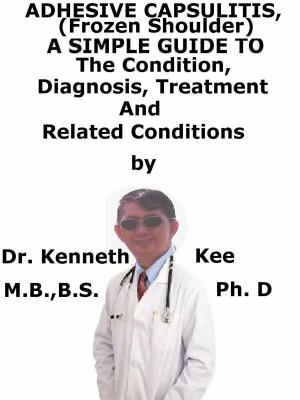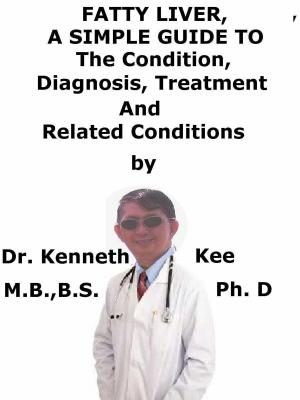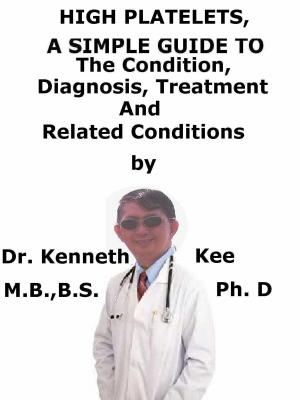Diabetes Insipidus, A Simple Guide To The Condition, Diagnosis, Treatment And Related Conditions
Nonfiction, Health & Well Being, Medical, Specialties, Internal Medicine, Endocrinology & Metabolism, Health, Ailments & Diseases, Diabetes| Author: | Kenneth Kee | ISBN: | 9781370483853 |
| Publisher: | Kenneth Kee | Publication: | October 5, 2016 |
| Imprint: | Smashwords Edition | Language: | English |
| Author: | Kenneth Kee |
| ISBN: | 9781370483853 |
| Publisher: | Kenneth Kee |
| Publication: | October 5, 2016 |
| Imprint: | Smashwords Edition |
| Language: | English |
Diabetes Insipidus is a rare disease which is characterized by the absence of antidiuretic hormone (ADH) resulting in a copious flow of dilute urine and excessive thirst.
Diabetes insipidus is a not common condition in which the kidneys are unable to prevent the excretion of water.
During the day, the kidneys filter all the blood many times.
Normally, most of the water is reabsorbed, and only a small amount of concentrated urine is excreted.
Central Diabetes insipidus occurs when the kidneys cannot concentrate the urine normally, and a large amount of dilute urine is excreted.
The amount of water passed out in the urine is controlled by antidiuretic hormone (ADH).
ADH is a hormone which is formed in a part of the brain called the hypothalamus.
The pituitary gland stores ADH in the posterior lobe and releases it when the body requires it.
Nephrogenic Diabetes insipidus occurs as a result from a defect in the kidneys.
Consequently the kidneys will not react to the effects of ADH.
1. Central diabetes insipidus may be controlled with vasopressin (desmopressin) in the form of tablets, injections or nasal sprays.
2. If nephrogenic Diabetes insipidus is caused by drugs, stopping the medicines such as lithium may help the restoration of normal kidney function.
3. Medicines that lower urine output also need to be taken.
4. Nephrogenic DI is treated with anti-inflammatory medicines and thiazide diuretics (water pills).
5. Oral chlorpropamide, carbamazepine or cofibrate may also help in some patients or in combination
TABLE OF CONTENT
Introduction
Chapter 1 Diabetes Insipidus
Chapter 2 Causes
Chapter 3 Symptoms
Chapter 4 Diagnosis
Chapter 5 Treatment
Chapter 6 Prognosis
Chapter 7 Hypopituitarism
Epilogue
Diabetes Insipidus is a rare disease which is characterized by the absence of antidiuretic hormone (ADH) resulting in a copious flow of dilute urine and excessive thirst.
Diabetes insipidus is a not common condition in which the kidneys are unable to prevent the excretion of water.
During the day, the kidneys filter all the blood many times.
Normally, most of the water is reabsorbed, and only a small amount of concentrated urine is excreted.
Central Diabetes insipidus occurs when the kidneys cannot concentrate the urine normally, and a large amount of dilute urine is excreted.
The amount of water passed out in the urine is controlled by antidiuretic hormone (ADH).
ADH is a hormone which is formed in a part of the brain called the hypothalamus.
The pituitary gland stores ADH in the posterior lobe and releases it when the body requires it.
Nephrogenic Diabetes insipidus occurs as a result from a defect in the kidneys.
Consequently the kidneys will not react to the effects of ADH.
1. Central diabetes insipidus may be controlled with vasopressin (desmopressin) in the form of tablets, injections or nasal sprays.
2. If nephrogenic Diabetes insipidus is caused by drugs, stopping the medicines such as lithium may help the restoration of normal kidney function.
3. Medicines that lower urine output also need to be taken.
4. Nephrogenic DI is treated with anti-inflammatory medicines and thiazide diuretics (water pills).
5. Oral chlorpropamide, carbamazepine or cofibrate may also help in some patients or in combination
TABLE OF CONTENT
Introduction
Chapter 1 Diabetes Insipidus
Chapter 2 Causes
Chapter 3 Symptoms
Chapter 4 Diagnosis
Chapter 5 Treatment
Chapter 6 Prognosis
Chapter 7 Hypopituitarism
Epilogue















